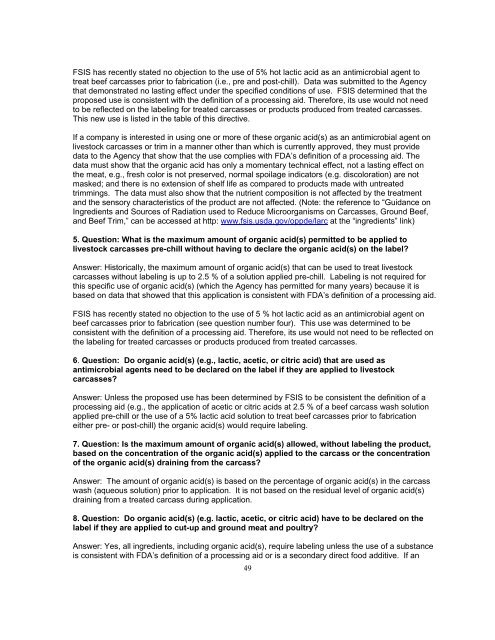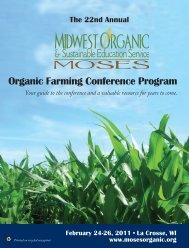Safe and Suitable Ingredients - GoodFood World
Safe and Suitable Ingredients - GoodFood World
Safe and Suitable Ingredients - GoodFood World
You also want an ePaper? Increase the reach of your titles
YUMPU automatically turns print PDFs into web optimized ePapers that Google loves.
FSIS has recently stated no objection to the use of 5% hot lactic acid as an antimicrobial agent to<br />
treat beef carcasses prior to fabrication (i.e., pre <strong>and</strong> post-chill). Data was submitted to the Agency<br />
that demonstrated no lasting effect under the specified conditions of use. FSIS determined that the<br />
proposed use is consistent with the definition of a processing aid. Therefore, its use would not need<br />
to be reflected on the labeling for treated carcasses or products produced from treated carcasses.<br />
This new use is listed in the table of this directive.<br />
If a company is interested in using one or more of these organic acid(s) as an antimicrobial agent on<br />
livestock carcasses or trim in a manner other than which is currently approved, they must provide<br />
data to the Agency that show that the use complies with FDA’s definition of a processing aid. The<br />
data must show that the organic acid has only a momentary technical effect, not a lasting effect on<br />
the meat, e.g., fresh color is not preserved, normal spoilage indicators (e.g. discoloration) are not<br />
masked; <strong>and</strong> there is no extension of shelf life as compared to products made with untreated<br />
trimmings. The data must also show that the nutrient composition is not affected by the treatment<br />
<strong>and</strong> the sensory characteristics of the product are not affected. (Note: the reference to “Guidance on<br />
<strong>Ingredients</strong> <strong>and</strong> Sources of Radiation used to Reduce Microorganisms on Carcasses, Ground Beef,<br />
<strong>and</strong> Beef Trim,” can be accessed at http: www.fsis.usda.gov/oppde/larc at the “ingredients” link)<br />
5. Question: What is the maximum amount of organic acid(s) permitted to be applied to<br />
livestock carcasses pre-chill without having to declare the organic acid(s) on the label?<br />
Answer: Historically, the maximum amount of organic acid(s) that can be used to treat livestock<br />
carcasses without labeling is up to 2.5 % of a solution applied pre-chill. Labeling is not required for<br />
this specific use of organic acid(s) (which the Agency has permitted for many years) because it is<br />
based on data that showed that this application is consistent with FDA’s definition of a processing aid.<br />
FSIS has recently stated no objection to the use of 5 % hot lactic acid as an antimicrobial agent on<br />
beef carcasses prior to fabrication (see question number four). This use was determined to be<br />
consistent with the definition of a processing aid. Therefore, its use would not need to be reflected on<br />
the labeling for treated carcasses or products produced from treated carcasses.<br />
6. Question: Do organic acid(s) (e.g., lactic, acetic, or citric acid) that are used as<br />
antimicrobial agents need to be declared on the label if they are applied to livestock<br />
carcasses?<br />
Answer: Unless the proposed use has been determined by FSIS to be consistent the definition of a<br />
processing aid (e.g., the application of acetic or citric acids at 2.5 % of a beef carcass wash solution<br />
applied pre-chill or the use of a 5% lactic acid solution to treat beef carcasses prior to fabrication<br />
either pre- or post-chill) the organic acid(s) would require labeling.<br />
7. Question: Is the maximum amount of organic acid(s) allowed, without labeling the product,<br />
based on the concentration of the organic acid(s) applied to the carcass or the concentration<br />
of the organic acid(s) draining from the carcass?<br />
Answer: The amount of organic acid(s) is based on the percentage of organic acid(s) in the carcass<br />
wash (aqueous solution) prior to application. It is not based on the residual level of organic acid(s)<br />
draining from a treated carcass during application.<br />
8. Question: Do organic acid(s) (e.g. lactic, acetic, or citric acid) have to be declared on the<br />
label if they are applied to cut-up <strong>and</strong> ground meat <strong>and</strong> poultry?<br />
Answer: Yes, all ingredients, including organic acid(s), require labeling unless the use of a substance<br />
is consistent with FDA’s definition of a processing aid or is a secondary direct food additive. If an<br />
49



